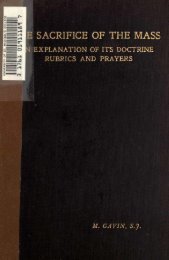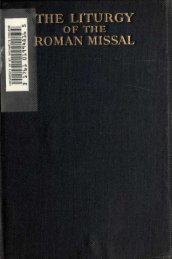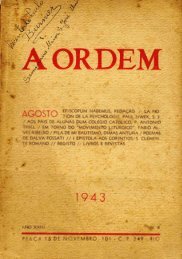E SACRIFICE OF THE MASS
E SACRIFICE OF THE MASS
E SACRIFICE OF THE MASS
You also want an ePaper? Increase the reach of your titles
YUMPU automatically turns print PDFs into web optimized ePapers that Google loves.
52<br />
<strong>THE</strong> TRACT.<br />
triumphant Alleluia takes its place. (See the Holy<br />
Sacrifice of the Mass, Gihr. English translation, p. 461.)<br />
The ancient baptismal rite on Holy Saturday has<br />
long since fallen into disuse, but the Gradual in<br />
Easter Week is retained. Another survival of an old<br />
custom.<br />
The Tract.<br />
In certain seasons, as from Septuagesima to Easter,<br />
the joyful Alleluia is exchanged for the Tract, which is<br />
of a mournful character. The word Tract is derived<br />
from tractim ; Tract meant something sung tractim,<br />
without break or interruption of other voices as in<br />
responsories and antiphony. The Tract is usually taken<br />
from Scripture, very often from the Psalms. Its<br />
character or tone sometimes resembles the Gradual<br />
(see for example the Gradual and Tract in the Votive<br />
Mass of the Holy Ghost after Septuagesima, and in<br />
Requiem Masses).<br />
The Sequence, sometimes called the Prose, from the<br />
irregularity of its metre, derived its name from the last<br />
vowel of the Alleluia which followed on through a series<br />
of notes without words. Different notes on one syllable<br />
without words may easily be difficult even to correct<br />
singers. In the tenth century words were put to these<br />
notes and this is the origin of what is now called a<br />
Sequence (a following on). Five are said or sung in<br />
church, the Victimae Paschali at Easter, the Veni Sancte<br />
Spivitus at Whitsuntide, the Lauda Sion for Corpus<br />
Christi ; the Stabat Mater and the Dies Irae.






